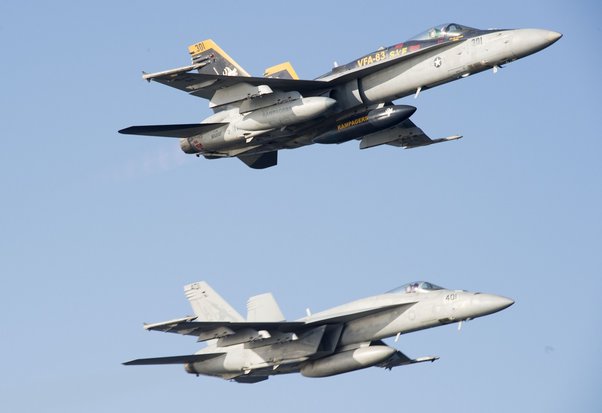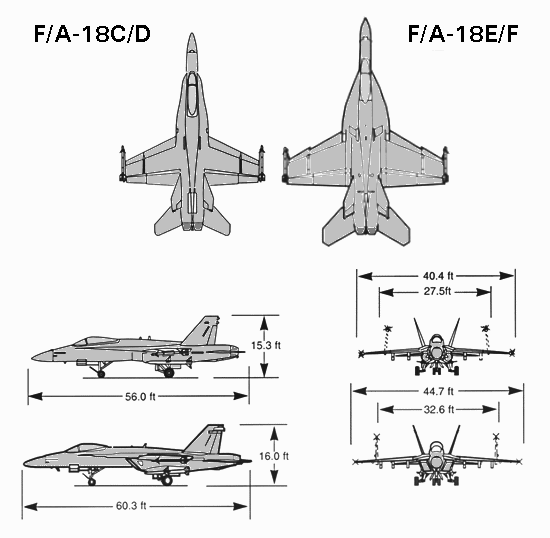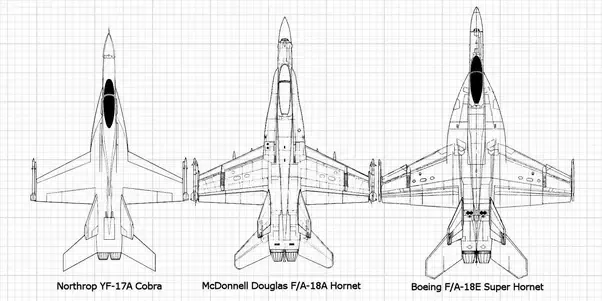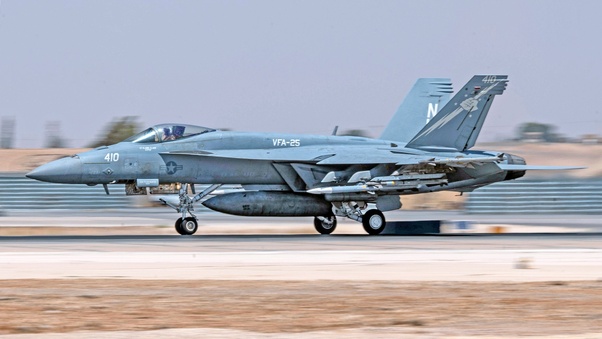First there are two aicraft known as the F/A-18 There is the original F/A-18 Hornet which is now called the legacy Hornet and there is the F/A-18 Super Hornet.
Here is an photo of both of them

The perspective makes it hard to see but the super hornet which is 401 is the larger of the planes. here are some diagrams


The YF-17 Cobra was a Northrop fighter designed to compete with the F-16 for the light fighter competition.
The original F/A-18 was desiegned to suplement the F-14. In the 1960s the US Navy, Marine Corps, and Air Force all used a common fighter the F-4 Phanotm II which was designed as a fleet defense interceptor with a secondary air superiority and air-to-ground missions. The F-4 Phantom was designed around the radar-guided Sparrow missile, which, on paper, meant it was capable of beyond visual range combat.
The Navy and the Air Force also had a joint strike fighter the A-7 Corsair II which ironically was not used by the Marines they stuck with the A-4 Skyhawk for their light attack plane. In both cases the USAF adopted a Navy fighter then tweaked it for their mission requirments.
The A-7 was a light attack plane which was the first American plane to use a HUD. The USAF bought the A-10 to replace the A-7 in the Close air support and Search and rescue escort roles.
When shopping for a replacement, the Navy picked the F-14, which was optimized for the fleet defense role with a secondary air superiority mission. The US bought the F-15, which was optimized for the air superiority mission. Both fighters had a secondary ground attack role, which wasn’t used.
The F-14 was designed around the large fire and forget Pheonix missile which had a range over 100 miles (160KM) for fleet defense missions and for air supperiorty they both carred a mix of shortrange sidewinders and sparrow missiles just like the F-4 Phantom II did.
In both cases the Navy and Air Force decided they could not buy enough F-14s and F-15s to replace all their F-4s which resulted in the light fighter competition.
The program was initially joint because both the Department of the Air Force and the Department of the Navy had similar requirements. They wanted a relatively cheap multi-role fighter to replace their remaining F-4 Phantom IIs, A-7s, and A-4s. However this resulted in two different sets of requirements.
The first was for a light fighter-bomber. These requirements were universal. The A-7 and A-4 were both simple mauverable strike planes which had limited air-to-air capability.
The A-7 was an evolution of the F-8 Crusader air superiority fighter, and the A-4, even though it was also subsonic, handled like an F-86, MiG-15, or MiG-17. Due to the limits of 1960s technology the F-4 was mostly used with in visual range during the Vietnam war.
A lot of people make a big to do about the F-4 being limited to visual range during the Vietnam war but it was due to the reliability of 1960s IFF and radar. Late in the Vietnam war the USAF upgraded some of their F-4D’s IFF gear so they could engage in BVR combat.
The second was for a discount air superiority fighter, which would have little, if any air-to-ground capability but the main focus would be something that would perform at least as well in a BVR engagement as the upgraded IFF system mentioned earlier this was a Navy and Marine Corps requriment
The Department of the Navy left the program because they felt the F-17 was easier to convert to a Naval fighter. Initially they had plans for two differnt fighters the F-18 which would be the air superiority version and the A-18 which would be the strike version.
So the program became the F/A-18 but it became clear that the two planes would be the same except software so the F/A-18 became a single plane.
In the 1980s there were plans to replace the F-14 with a navalized version of the ATF and the A-6 with the A-12 but both were canceled. So this meant that until something esle came about the Navy and Marine corps would need a new strike fighter.
Gruman’s plan was the F-14 Super Tomcat 21 and McDonnel-Douglas had the F/A-18 Super Hornet.
Here are the advantages the F-14 had over the F/A-18 of any type
Speed, the F-14 is faster and can reach Mach 2.3 while the F/A-18 sticker speed is Mach 1.8
Range due to the F-14’s size it can carry a lot more fuel and stay in a fight longer
Here is where the F/A-18 Super Hornet beat the Tomcat
Maintainablility
Maintaining the F/A-18 requires upwards of 15 maintenance hours per flight hour while the Tomcat required about 60 hours. Maintanance hours doesn’t mean a Hornet will be sitting in a hanger for 15 hours after flying 1 hour.
It means a ground crew of 15 people will be working for 1 hour to get the F/A-18 ready for flight. So Super Hornet would be in the air, taking on the enemy while the Tomcat is in the hanger still getting prepared for a mission
Quite the opposite. The F-18, especially the Super Hornet, is clearly better for the modern age.
First of all, the F-14 was an interceptor; it was designed to stop Soviet bombers from launching their missiles against the carriers. It got a lot of hype thanks to Top Gun.
The F-18, on the other hand, is a multirole aircraft. One moment they can be a strike aircraft and, right after they fired their ground/surface ordnances, they can be a formidable fighter. The Super Hornet (effectively a redesign of the original, despite its very similar looks) makes it even better.

This sort of flexibility allowed it to replace all fixed-wing combat jets on a carrier (including electronic warfare with the EA-18G), making logistics a lot simpler. Only the F-35 is better because of their “true” stealth, as opposed to the Super Hornet’s “semi” stealth.
The F-14 was meant to be upgraded to the 21st century, but it never came true because of cost concerns. The last version flown was a fighter with limited ground attack capability vs true multirole of the F-18. It’s rather obvious which one is more useful.






